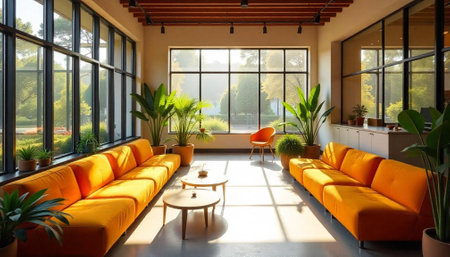Introduction to Mid-Century Modern Homes
Mid-century modern homes stand as iconic representations of American architectural innovation, especially in the years following World War II. Rooted in the optimism and rapid suburban growth of the post-war era, this design movement redefined residential living by embracing a harmonious relationship between built environments and the natural world. Emerging during the late 1940s through the 1960s, mid-century modern architecture responded to both social change and advances in building technology, offering a fresh perspective that broke away from traditional, ornamented styles. Characterized by simplicity, clean lines, and functional layouts, these homes prioritized open floor plans and large windows that blurred boundaries between indoor and outdoor spaces. The use of organic materials—such as wood, stone, and glass—became hallmarks of the style, reinforcing its connection to nature. As we explore the outdoor influence on mid-century modern homes throughout this article, it’s essential to understand how their origins were deeply intertwined with American values of innovation, accessibility, and a desire to live closer to nature.
2. The Role of the Outdoors in Home Design
During the mid-20th century, American society experienced dramatic cultural and lifestyle shifts that fundamentally changed residential architecture. Following World War II, suburban expansion flourished as families sought homes that supported relaxation, recreation, and a closer connection to nature. This era marked the rise of Mid-Century Modern design, where architects intentionally blurred the lines between indoor and outdoor spaces to reflect new values and aspirations.
The Appeal of Outdoor Entertaining and Relaxation
American homeowners began to see their yards and patios not just as functional spaces, but as extensions of their living areas. The growing popularity of backyard barbecues, pool parties, and casual gatherings highlighted a shift toward informal entertaining. Open floor plans, sliding glass doors, and expansive windows were introduced to seamlessly connect interiors with landscaped gardens or patios, inviting natural light and fresh air into daily life.
Lifestyle Shifts Shaping Home Design
| Factor | Description | Impact on Home Design |
|---|---|---|
| Postwar Suburban Growth | Families moved out of cities seeking more space and tranquility. | Larger lots allowed for private outdoor areas directly connected to homes. |
| Rise of Leisure Culture | Increased disposable income led to greater emphasis on relaxation at home. | Architects designed homes with patios, decks, and pool areas for entertainment. |
| Technological Advances | Innovations in glass and steel construction enabled larger openings to the outdoors. | Homes featured floor-to-ceiling windows and sliding doors for seamless transitions. |
| Cultural Emphasis on Health & Nature | A growing appreciation for sunlight, greenery, and fresh air emerged. | Designs integrated indoor plants, open courtyards, and garden views into everyday living. |
A Lasting Influence on American Homes
This blending of nature and design became a signature element of Mid-Century Modern homes across the U.S., setting the stage for generations of Americans to embrace outdoor living as an essential aspect of modern comfort. By prioritizing flexible spaces that foster connection with the environment, these designs continue to shape how we view our homes today.

3. Signature Design Elements That Invite Nature In
Mid-century modern homes are renowned for their ability to blur the boundaries between indoor comfort and the outdoor environment. At the heart of this architectural philosophy are signature design elements that celebrate nature, making it an integral part of daily living.
Floor-to-Ceiling Windows: Framing the Outdoors
One of the most iconic features of mid-century modern design is the extensive use of floor-to-ceiling windows. These expansive glass panels do more than just let in natural light—they frame picturesque views, turning every season into a living piece of art within the home. In American suburbs and cities alike, these windows became symbols of transparency and openness, inviting the outside world in while maintaining a sense of privacy and comfort.
Open Floor Plans: Flowing Spaces
The open floor plan is another hallmark that reflects the era’s desire to connect with nature. By minimizing interior walls and creating seamless transitions between living, dining, and kitchen areas, these homes encourage both movement and togetherness. This spatial freedom allows sunlight to flood multiple rooms at once, ensuring that natural illumination and scenic vistas become focal points throughout the house.
Courtyards: Private Outdoor Retreats
Integrated courtyards serve as tranquil sanctuaries within many mid-century modern homes. Enclosed yet open to the sky, these spaces offer homeowners a private connection to nature—perfect for morning coffee or evening gatherings under the stars. Whether lushly landscaped or simply adorned with native plants, courtyards reinforce the idea that life flows seamlessly from inside to out.
Together, these architectural elements create a harmonious balance between structure and landscape. They not only enhance visual appeal but also support well-being by maximizing daylight, fresh air, and opportunities to enjoy nature—core values that continue to define American mid-century modern living today.
4. Landscaping as an Extension of Living Space
In mid-century modern homes, landscaping is not just about curb appeal—it’s a thoughtful extension of the living space. By intentionally designing patios, gardens, and incorporating native plantings, homeowners can carry the clean lines and open feel of their interiors into the great outdoors. This approach transforms traditional backyards into functional outdoor rooms that mirror the style and comfort found inside. Patios are often positioned as transitional zones, blurring boundaries between indoor and outdoor areas with materials and layouts that echo interior finishes. Gardens are curated to enhance both beauty and usability, often featuring low-maintenance native plants that thrive in local climates while supporting sustainability. The use of native species also reduces water consumption and integrates the home seamlessly into its natural surroundings.
| Landscaping Feature | Design Purpose | Mid-Century Modern Influence |
|---|---|---|
| Patios | Create outdoor living/dining zones; extend entertaining space | Clean lines, concrete or stone surfaces, connection to indoor flooring |
| Gardens | Add visual interest; provide relaxation spaces | Geometric planting beds, integration with windows/views |
| Native Plantings | Support sustainability; reduce maintenance | Reflect local landscape; blend home with environment |
By weaving these elements together, mid-century modern landscaping achieves a harmonious flow from inside to out. Whether you’re hosting friends on a breezy patio or enjoying a peaceful moment among sculptural plants, intentional landscape design helps transform every square foot of your property into functional—and beautiful—living space.
5. Modern Applications in Today’s Homes
The influence of mid-century modern design continues to thrive in contemporary American homes, with homeowners and architects placing renewed emphasis on sustainability, energy efficiency, and a seamless connection between indoor and outdoor living spaces. Today’s reinterpretations take the foundational principles of mid-century modern style—such as open floor plans, large windows, and integration with nature—and adapt them to meet current environmental and lifestyle needs.
Embracing Sustainability
Modern builds inspired by mid-century aesthetics prioritize sustainable materials like reclaimed wood, low-VOC finishes, and energy-efficient glass. Green roofs, rainwater harvesting systems, and solar panels are increasingly common features, reflecting a commitment to reducing environmental impact while maintaining the clean lines and organic forms that define the style.
Energy Efficiency at the Forefront
Energy-smart design is central to today’s mid-century modern-inspired homes. Double-pane windows, advanced insulation techniques, and passive solar orientation are used to maximize comfort while minimizing energy use. These strategies echo the original movement’s focus on practical innovation and respect for natural resources.
Blurring Boundaries: Indoors and Out
The tradition of blending indoor and outdoor spaces is alive and well in current home designs. Expansive sliding glass doors, covered patios, and continuous flooring materials create a fluid transition between the interior and exterior. Outdoor rooms equipped with comfortable seating, fire pits, or outdoor kitchens allow families to enjoy nature year-round—a hallmark of American living that draws directly from mid-century ideals.
Innovative Technology Meets Classic Design
Today’s technology further enhances these homes’ functionality without sacrificing their timeless appeal. Smart thermostats, automated window coverings, and integrated lighting systems offer convenience while supporting energy conservation goals. This blend of retro inspiration with cutting-edge solutions ensures that the mid-century modern legacy remains relevant for a new generation of homeowners.
A Lasting Influence
By merging classic design elements with sustainable practices and advanced technology, contemporary homes honor the spirit of mid-century modernism while meeting the demands of modern American life. The enduring appeal lies in its adaptability—a true testament to the value of integrating nature with thoughtful design.
6. Conclusion: Lasting Legacy of Outdoor-Influenced Design
As we reflect on the enduring impact of outdoor influence in mid-century modern homes, it’s clear that this architectural approach has left a permanent mark on American residential design. By blurring the lines between inside and out, these homes invite natural light, fresh air, and organic materials into daily life, creating spaces that feel both contemporary and timeless. This ongoing connection to the outdoors nurtures well-being and promotes a lifestyle that values both comfort and sustainability. Even today, homeowners and designers draw inspiration from mid-century principles, integrating large windows, sliding glass doors, and seamless patios to keep nature close at hand. The legacy of outdoor-influenced design endures not only because of its aesthetic appeal but also due to its ability to foster a meaningful relationship between people, their homes, and the world outside—a relationship that continues to shape how Americans envision the perfect living space.


